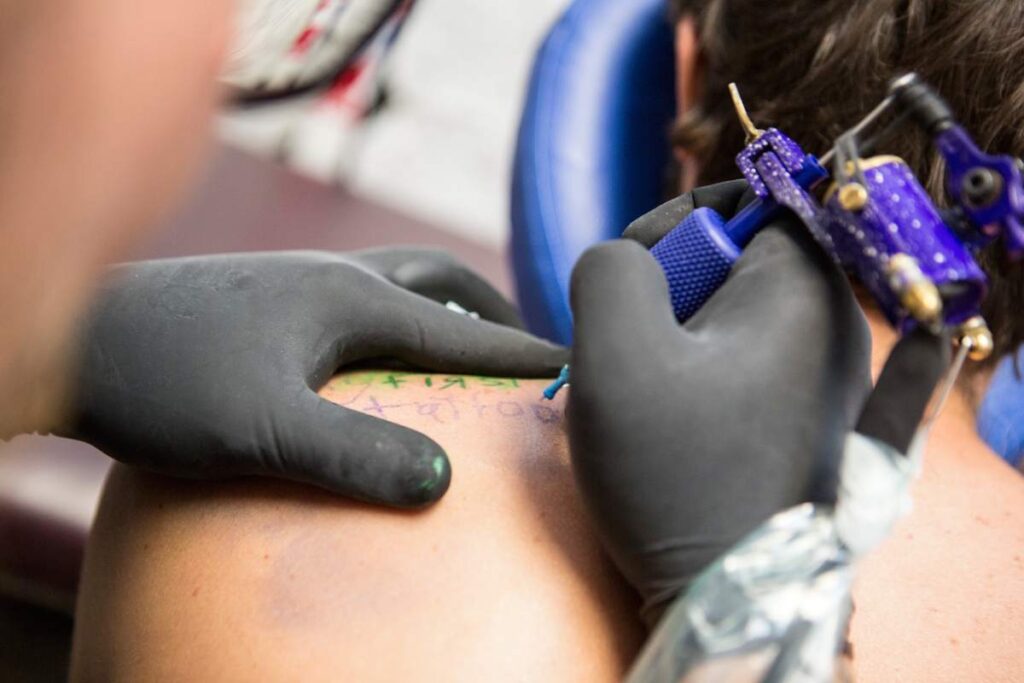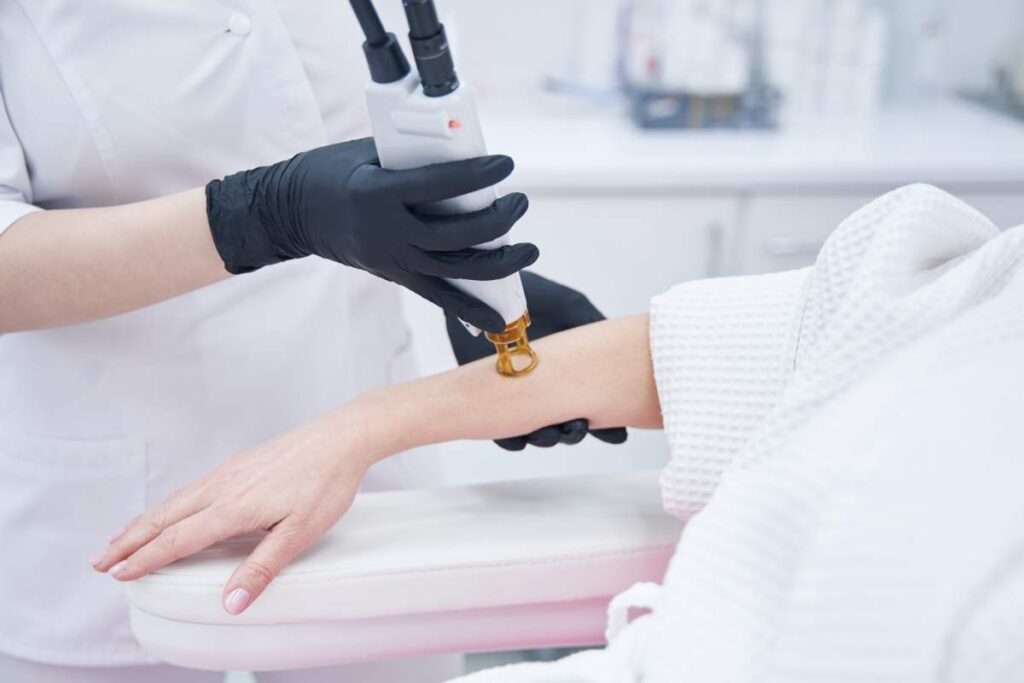Removing a tattoo can be a significant decision, and understanding the process, pain level, and costs involved can help you make an informed choice. Tattoo removal has evolved with advanced technology, making the process safer and more effective.
Here’s what you need to know about how tattoo removal works, how painful it is, and what to expect in terms of cost if you’re considering tattoo removal in Thailand.
How Does Tattoo Removal Work?
The most common tattoo removal method today is laser tattoo removal. This process uses high-intensity light beams that target the ink particles in the skin, breaking them down into smaller fragments that the body’s immune system can absorb and eliminate naturally over time.
The Science Behind Laser Tattoo Removal
Laser tattoo removal works by directing a concentrated light at the tattoo. This light selectively targets the tattoo ink without affecting the surrounding skin. Different ink colours respond to different laser wavelengths, so multiple types of lasers may be used depending on the colours in the tattoo.
- Ink Absorption: The ink particles absorb the laser light, which causes them to heat up and shatter.
- Immune Response: After the particles are broken down, the immune system begins to flush the ink particles out. The process occurs gradually, which is why several sessions are usually required for complete removal.
Types of Lasers Used
- Q-Switched Lasers: The Q-Switched laser is widely used in tattoo removal because it delivers short, high-energy pulses to break down ink particles effectively.
- PicoSure Laser: This is a picosecond laser that delivers pulses at a very high speed, creating less heat and causing less damage to surrounding skin. It’s effective on stubborn colours like blue and green and can reduce the overall number of sessions required.
- YAG Lasers: These lasers are commonly used for dark ink colours such as black and dark blue.
How Many Sessions Are Required?
Tattoo removal typically requires multiple sessions, ranging from 5 to 10 or more, depending on factors like:
- Tattoo Size: Larger tattoos may need more sessions.
- Ink Color and Density: Lighter colours and densely packed ink are harder to remove.
- Location on the Body: Tattoos on areas with better blood circulation (like arms and chest) may fade more easily.
- Skin Type: Different skin types can affect how quickly and effectively the ink is removed.
Sessions are usually spaced 4 to 8 weeks apart to allow the skin to heal and the immune system to clear the ink particles.

Does Tattoo Removal Hurt?
Pain tolerance varies from person to person, but most people report that tattoo removal can be uncomfortable. The pain of tattoo removal is often compared to the sensation of a rubber band snapping against the skin or the stinging of sunburn.
Some also describe it as similar to getting the tattoo itself but more intense in some cases but it’s sure hurt more than getting a flu shot.
Pain Factors in Tattoo Removal
- Location of the Tattoo: Sensitive areas, such as the ribs, inner arms, or wrists, tend to be more painful compared to areas with thicker skin.
- Size of Tattoo: Larger tattoos mean a longer session time, which may increase discomfort.
- Type of Laser Used: PicoSure lasers, due to their speed, may reduce the sensation of heat and pain as they don’t require as many pulses as other lasers.
- Tattoo Age: Older tattoos may have faded ink, which can be easier and less painful to remove.
Pain Management Options
To ease discomfort, clinics offer options to reduce pain during the session:
- Topical Anesthetics: Numbing creams applied before the session can reduce the sensation.
- Cooling Devices: Some clinics use air-cooling systems to alleviate pain during and after the session.
- Pain Medications: Over-the-counter pain relievers like ibuprofen can also help, but consult the clinic first to avoid any reactions with the treatment.
Risks and Side Effects of Tattoo Removal
Tattoo removal, while generally safe, can come with some side effects and risks. The most common side effects include:
- Redness and Swelling: The skin may be red and swollen for a few days after treatment.
- Blisters and Scabs: These are part of the healing process and should not be picked to avoid scarring.
- Temporary Discoloration: Some people may experience temporary lightening or darkening of the skin, which usually resolves over time.
- Scarring: Although rare with advanced laser technology, scarring is still a possibility, especially if the skin is not cared for properly during recovery.
Most reputable clinics in Thailand use advanced equipment and trained professionals, significantly reducing these risks.

Tattoo Removal Costs in Thailand
Tattoo removal costs in Thailand can vary widely depending on the clinic, the laser technology used, and the size and complexity of the tattoo.
Average Cost Breakdown
- Small Tattoos (1-3 cm): The cost typically ranges between THB 1,500 to 3,500 per session (approx. AUD 60 to 150).
- Medium Tattoos (4-10 cm): Expect to pay around THB 4,000 to 7,000 per session (approx. AUD 170 to 300).
- Large Tattoos (more than 10 cm): Prices for larger tattoos can start at THB 8,000 per session (approx. AUD 350) and go up depending on size and colour complexity.
The total cost will depend on the number of sessions needed, which can vary based on the factors mentioned earlier. A large, colourful tattoo may require up to 10 sessions, making it important to consult with your chosen clinic to get an accurate estimate of both the time and financial commitment.
Why Consider Tattoo Removal in Thailand?
Thailand is known for its advanced healthcare facilities and skilled professionals, particularly in cosmetic and aesthetic treatments. Many clinics in Thailand offer tattoo removal services using state-of-the-art technology, making it an appealing destination for individuals looking to remove tattoos effectively and affordably.
Benefits of Tattoo Removal in Thailand
- Advanced Laser Technology: Many clinics in Thailand are equipped with PicoSure, Q-Switched, and YAG lasers, ensuring that patients receive top-tier treatment.
- Skilled Practitioners: Thailand has many trained professionals specializing in laser treatments and cosmetic procedures.
- Cost-Effective: Compared to Western countries, tattoo removal in Thailand can be significantly more affordable without compromising on quality.
- Medical Tourism: Thailand is popular among international patients for medical tourism, so many clinics have services tailored for overseas visitors, often including English-speaking staff and consultation services.
Choosing the Right Clinic in Thailand
When choosing a clinic in Thailand for tattoo removal, consider the following:
- Certification and Experience: Look for clinics with certified practitioners experienced in tattoo removal.
- Equipment Quality: Clinics using advanced technology like PicoSure or Q-Switched lasers generally offer better results.
- Clinic Reviews: Check online reviews or patient testimonials to get a sense of the clinic’s reputation.
- Consultation Services: A reputable clinic should offer a consultation to assess your tattoo and discuss the expected outcome, risks, and costs.
If you’re planning to travel to Thailand in the near future, and coincidently want your tattoos removed, we suggest getting consult with Kamol Hospital in Bangkok. They are one of the world’s leading cosmetic surgery hospitals that can fulfil your desire for self-improvement and a boost in confidence in every aspect.
Final Thoughts
Tattoo removal is a complex process requiring careful planning, especially for large or colourful tattoos. In Thailand, you can access high-quality tattoo removal services at a reasonable price.
Although the process may involve some discomfort, various pain management options are available to make the experience as manageable as possible. By choosing a reputable clinic, you can ensure that your tattoo removal journey is both safe and effective.




